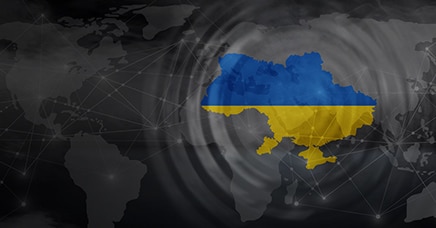Transforme su estrategia
Tres pasos para la ruta
-
Visión General
-
Responder ante la incertidumbre
-
Reevaluar la arquitectura empresarial
-
Definir el núcleo y el borde
Un catalizador para la transformación estratégica
Podríamos pensar en la resiliencia como la capacidad de ir más allá de simplemente responder y recuperarse de desafíos inesperados, para crecer y evolucionar de maneras que creen más valor en el futuro. En lugar de simplemente "regresar" a donde estábamos antes, deberíamos buscar nuevas formas de interconectar nuestras actividades y prosperar.
Esto significa mirar hacia el futuro, desafiar nuestros supuestos básicos acerca de en qué negocio estamos realmente y anticipar oportunidades que nadie ha visto aún. Esta puede ser una perspectiva desalentadora en tiempos "normales", pero el contexto de la pandemia podría proporcionar el estímulo que necesitamos para aprovechar el momento.

Responding to uncertainty
Recent business history provides many instances of giants toppled by misunderstandings of uncertainty. To misquote Donald Rumsfelt, embracing uncertainty means knowing what you know, knowing what you don’t or can’t know, and knowing the difference In our experience, most executives and boards tend toward one of two types of response to uncertainty:
- Lack of confidence: They recognize its existence, depth, and complexity, but become paralyzed by it, resulting in slow, timid or erratic decision-making.
- Overconfidence: The complexities to be faced are dismissed as though they could be wished away. This results in hasty, superficial assessments and simplistic answers (often based on mis-analogies of past experience).
Embracing uncertainty means knowing what you know, knowing what you don’t or can’t know, and knowing the difference.
Taking action
How we act in the face of uncertainty has been a defining theme of modern business, even within a context of macroeconomic stability and continuity. Exceptional circumstances, such those we have been experiencing under the pandemic, require a blend of courage, clarity, and humility. The biggest enemies of good decision-making in times of deep crisis are neither uncertainty nor ambiguity; they are, rather, over-confidence, procrastination, and incomplete or biased data.

Scenario planning
Intelligent scenario-thinking, when executed well, can mitigate the risk of falling into the trap of over-confidence when anticipating future possibilities. It can, similarly, reduce or remove hesitation altogether by providing a logical structure to challenge and validate underlying assumptions. Also, by reducing the risk of incomplete and biased data (by combining expert intuition with objectively measured qualitative data) it provides one of the most dependable ways to build the resilient any organisation needs to face future uncertainty with confidence.

Reevaluating architecture
The pandemic has caused a reevaluation of the fundamental architectures that support our organizations. By architectures we’re not referring to the buildings, but the way we connect all our activities, people and resources to deliver value to our stakeholders. This is more than an integration of our business and technology strategies, rather it relates to the underlying architectures that we need to support our activities, and which reflect the environment around us. For decades these architectures have been built and developed around prevailing conditions that have been comparatively constant. Given the accelerating changes in today’s environment, there is a growing need to reshape them to reflect a very different set of conditions.
In addition to business architectures, which refer to the connections between the activities, people and resources operating our businesses, there are technology architectures that interconnect all the devices, software, and data that we need to run the businesses.
Look, for example, at the global supply chains on which we rely. On the business side, we have explicit agreements on how the participants in the supply chain will support each other, specifying the activities to be performed and outcomes to be delivered. On the technology side, elements are hard-wired to support predetermined activities. Both business and technology architectures have been designed to ensure that participants in supply chains act in tightly specified ways.

Architecture that keeps changing
Traditional static architectures are now creating barriers to further evolution, not only preventing us from addressing rapidly growing opportunities but also creating more vulnerability in a rapidly changing world. Rather than viewing business and technology architectures as distinct, static entities we should now see them as dynamic, interconnected systems that continually evolve by interacting with each other. In addition to greater flexibility and agility, interactive architectures enable all participants to learn faster and to accelerate performance improvements enabling the strategically resilient organization to thrive by creating more and more value in challenging times—as well as responding quickly to unforeseen events. In short, it can do more, more quickly with fewer resources.

Core and Edge
Most organizations engage in activities central to their core purpose. Around this many also engage (perhaps in partnership with third-parties) in a range of activities towards the edge of their operations. While the core is, naturally, central to the organization, the edge can provide a useful testing ground for future opportunities and potential new business activities that, in time, could become core to the business.
The edge holds the key to the future
A resilient organization will systematically nurture and develop selected opportunities at the edge of its operations that have the potential, in time, to strengthen their core business. This will often mean connecting with third-parties who are experts in the business sectors they want to explore and develop. Having set the future direction for the core, it can direct attention and resources into those activities at the edge that can have the greatest impact in accelerating their movement towards their core goals as swiftly as possible.

The core is central to the business
While the edge initiatives can help the organization target emerging opportunities, the core is still where the bulk of revenues and profits reside. The resilient organization must, therefore, also focus on performance improvements within the core of their business. In the current context it might look at where the pandemic has been most disruptive and take the opportunity to redesign the business and technology architectures for that part of the organization. If the products are no longer a good fit for shifting market needs, for example, it might focus on developing new products and tapping into new domains of expertise outside the firm (perhaps in the edge). If manufacturing has been disrupted, it might focus on evolving traditional supply chains into supply networks that can accelerate performance improvement, or if customer relationships have been disrupted, perhaps focus on rebuilding trust by becoming more proactive in delivering value to customers.

Strategic resilience means thinking holistically about the needs of the organization. From experimenting with new opportunities at the edge of the operation to strengthening the speed, responsiveness and agility at the core. To thrive through and beyond the current crisis means more than merely bouncing back to where we were before, it means developing ever deeper resilience that habitually turns adversity into a catalyst for growth.















